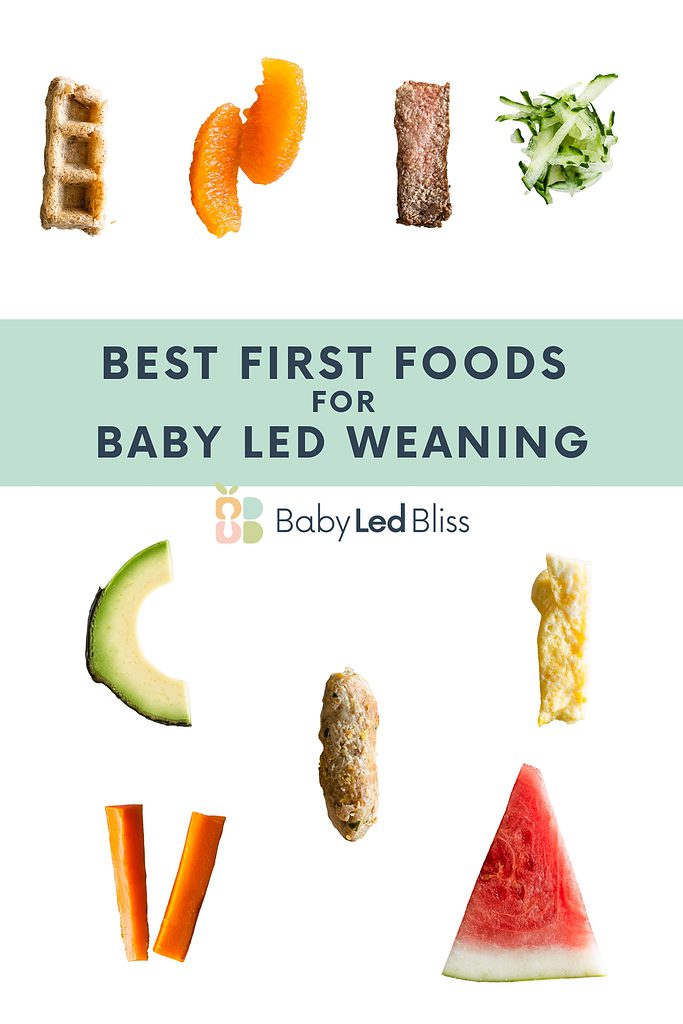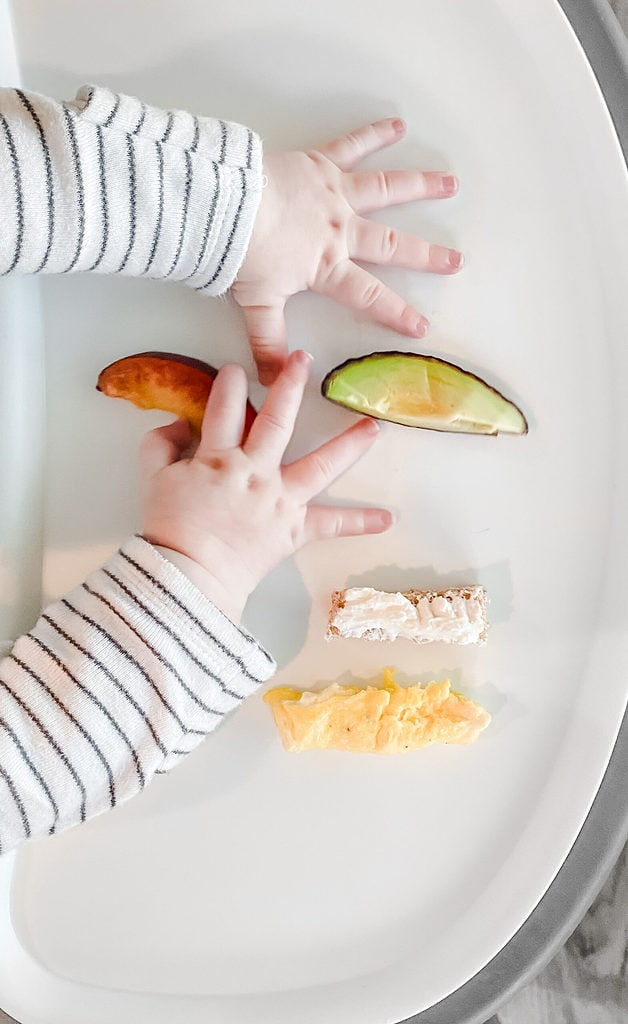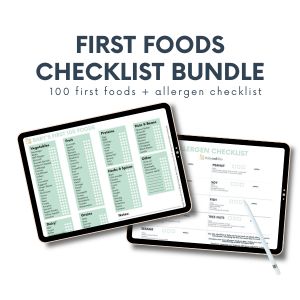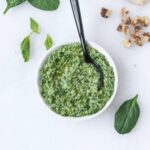What is the best first food when your baby is starting solids for the first time at 6 months? It may not be what you think. Here are registered dietitian-approved safe and healthy first foods for baby-led weaning - even if your baby has no teeth!

If you're feeding your baby in a conventional approach with purees, your pediatrician will likely tell you to start first with baby rice cereal, then with a single vegetable puree, then add another single vegetable puree, until you get through all the vegetables, then try fruit purees and meat purees, waiting a day to add each new food. At least that's what mine told me. That sounds a little stressful and outdated, no? Well guess what? It is! There's a better way. Read on for the BEST first foods for babies.
Jump to:
- Do I Have To Start With Rice Cereal When Starting Solids?
- What Foods Should I Introduce First With Baby Led Weaning?
- What Are We Looking For In Baby's First Foods?
- Best First Foods for Baby (About 6 Months of Age):
- Tips For Starting Out With First Foods:
- What Does a 6 Month Old's Baby Led Weaning Meal Look Like?
Do I Have To Start With Rice Cereal When Starting Solids?
You actually do NOT have to start with rice cereal, or go in any particular order when starting solids with your little one. There is no reason your baby can't jump right in with various solid foods! But if you aren't starting with rice cereal or purees at all, what DO you start with? If you're starting solids with a baby led weaning approach, your pediatrician may not be very knowledgeable or helpful with baby led weaning. That's why I'm guiding you through which foods to introduce to your baby first with baby led weaning!
What Foods Should I Introduce First With Baby Led Weaning?
Short answer: whatever you're already serving the family! The great thing about baby led waning is that it's SO flexible, so you can start with almost anything as long as it's an appropriate texture and shape, and isn't too high in salt or sugar. In general, it's best to go with whole foods prepared at home. Ideally, that's already what you're making for the family, making it easier for everyone!
What Are We Looking For In Baby's First Foods?
- Appropriate texture and shape. Can you mash it between your thumb and forefinger? Finger shaped is ideal. Read more about the smash test for texture and shape specifics here.
No added sugar and minimal salt until at least age 1. With salt, I'm a little more flexible (because you can't control everything) but if you can, keep the salt levels lower when cooking at home, and avoid highly processed packaged foods since they are super high in sodium. Babies also just don't need added sugar. In fact, the dietary guidelines recommend avoiding all added sugar until age 2. That means no regular table sugar, honey, maple syrup, or other added sweeteners. Honey also shouldn't be given to infants under 1 year because of the risk of botulism, which can make infants very sick.
Iron-rich food at least once per day. Starting around 6 months of age, the iron stores your baby received in utero start to deplete, so they need to start getting it from their diet, especially breastfed babies. Ideally you want one at every meal, but for sure at least once per day. (Grab my free download for maximizing baby's iron intake!)
High fat and high calorie. Infants need every little bit of nutrition they can get from each bite, so adding energy and nutrient rich foods is important. I add lots of foods like avocado, nut butters (just not big globs) and whole milk plain yogurt.
Be sure you are familiar with the safety guidelines to always follow with baby led weaning!

Best First Foods for Baby (About 6 Months of Age):
Beyond the guidelines above, just go for it! Give baby a taste of whatever the family is eating. No need to stick with unflavored steamed vegetables. In fact, spices and herbs are great! I recommend introducing only one allergen food per day to observe for reactions. Here are some great nutrient rich foods you can start introducing to your little one with baby led weaning. Just remember fruits and vegetables should be cooked to a soft texture and peeled if they aren't soft when raw.
Best Fruits and Veggies For Baby Led Weaning:
Avocado - sliced or mashed
- Asparagus - cooked soft and tough ends cut off
- Apples - cooked ONLY and with no peel
- Banana
- Beets - cooked soft
- Broccoli - cooked soft
- Carrots - cooked soft
- Cauliflower - cooked soft
Cucumber - in a big spear until baby has teeth, then grated
- Cantaloupe
Eggplant - cooked soft
- Green Beans - cooked soft
Kiwi
- Mango
Mushrooms - cooked soft
Oranges or grapefruit - segments only
- Peaches or nectarines - very ripe or cooked soft
- Pears - very ripe or cooked soft
Peppers - cooked soft
Peas - gently mashed
- Plums - ripe
Pineapple
- Pumpkin - cooked soft or canned
- Raspberries
- Strawberries
Summer squash or zucchini - cooked soft
- Tomatoes - large slices, no cherry or grape tomatoes!
- Watermelon - (seedless!) a wedge with the rind is just fine and makes for easier gripping
- Winter squash - cooked soft, without skin
Best Protein Foods for Baby Led Weaning:
Beans - lightly smashed or in the form of hummus
- Chicken - should be moist
Eggs - scrambled, hard cooked, boiled, or as an omlette or casserole
- Fish or Shrimp
- Ground beef, chicken, pork, or turkey
Meatballs - roll into a finger shape or cut big meatballs into slices
Nut butters - spread thinly or stirred into something, with no added sugar
- Soft cheese (I like whole milk mozzarella or ricotta because they're lower in sodium)
Steak - cut into finger-sized pieces (baby will suck the juices out and leave the rest)
- Turkey - should be moist
Whole milk yogurt
Best Starchy Carbs For Baby Led Weaning:
Baby muffins(with no added sugar)
- Oatmeal
Pancakes or waffles (with no added sugar) - cut into strips
Pasta - whole wheat or chickpea pasta (chickpea pasta is a good way to add iron and protein)
- Potatoes - wedges or mashed
Sweet Potatoes - wedges or mashed
Toast - very lightly toasted (no added sugar bread is a great vehicle for nutrient-dense spreads like nut butter and hummus!)
- Whole grains like quinoa and rice - made into balls with a bit of beans, or made into a porridge.

Track your baby's journey through starting solids! Get my 100 First Foods Checklist and Allergen Checklist Bundle today!
Tips For Starting Out With First Foods:
Don't get too stressed! It should be fun and a chance for baby to explore tastes and textures. The majority of baby's nutrition is still coming from breast milk or formula, so it's perfectly fine (and normal) if not much food makes it into his or her mouth for the first month or more.
For feeding puree-like textures (such as yogurt, hummus, nut butter, etc) you can spread a thin layer on very lightly toasted bread, load a soft spoon and hand it to baby, or just let them pick it up off the tray by itself. It WILL get messy, but that's how they learn.
Slippery foods may be rolled in something to help baby grip it (such as ground flaxseed, hemp seeds, or unsweetened shredded coconut). You can also leave the peel on a portion of the food to act as a grip (such as on half of an avocado slice)
Flavor is good! Other than salt and sugar, don't be shy to give baby foods flavored how your family eats them. Roasted veggies with herbs and spices, richly flavored sauces, and spiced oatmeal or breakfast porridge are all great ways for baby to explore new tastes. You wouldn't want to eat only plain, bland food every day, would you?
Feeding baby is much easier when your family cooks at home and makes minimally processed foods. That said, if you know you'll be eating somewhere else that may not have appropriate foods for baby, be prepared to bring a few things baby can eat.
Tiny bits of leftovers are great for babies starting out! Just a half meatball leftover from last night's dinner could be the perfect lunch for a 6 month old baby. They tend to eat anything at this age, so it really helps cut down on food waste.

What Does a 6 Month Old's Baby Led Weaning Meal Look Like?
Here are a few example meals to give you an idea:
Breakfasts:
Whole grain waffle spread with peanut butter or yogurt + scrambled egg + soft peaches
- Veggie and egg breakfast casserole cut into thin strips + Kiwi wedge with the peel on
Thick oatmeal with mashed banana, whole milk yogurt and cinnamon stirred in
Lunches:
Toast spread with mashed avocado + fresh mozzarella cheese + orange segments
- Chickpea pasta with pasta sauce + soft cooked broccoli florets
Leftover shredded chicken + hummus + cucumber spear
Dinners:
- Juicy hamburger patty (cut into finger-sized strip) + sliced avocado + sliced tomato cut into strips + sweet potato fry (pictured above)
- Baked salmon + roasted sweet potato wedge + soft cooked green bean
Grilled juicy steak (finger-sized pieces) + soft asparagus spear + mashed baked potato

















Leave a Reply